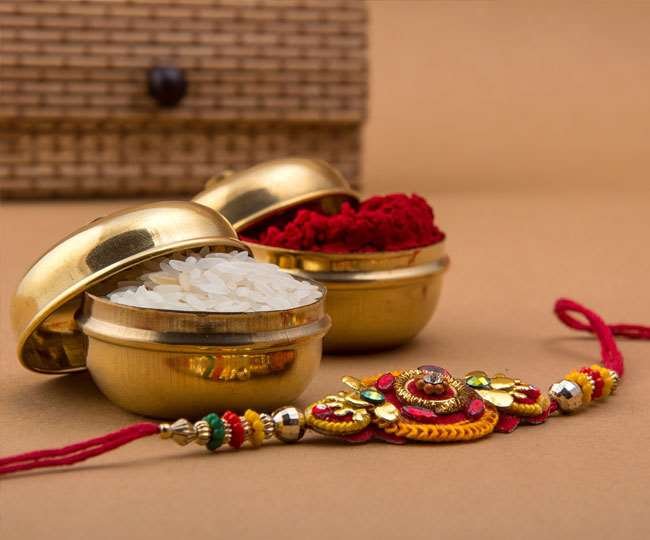Raksha Bandhan: The Deeper Significance

Celebrated in the Hindu month of Sravana (July/August), Raksha Bandhan celebrates the love of a brother for his sister.
On this day, sisters tie rakhi on the wrists of their brothers to protect them against evil influences and pray for their long life and happiness.
It is also a great sacred verse of unity, acting as a symbol of life's advancement and a leading messenger of togetherness. Raksha means protection, and in some places in medieval India, where women felt unsafe, they tie Rakhi on the wrist of men, regarding them as brothers. In this way, Rakhi strengthens the bond of love between brothers and sisters and revives the emotional bonding. Brahmins change their sacred thread (janoi) on this day and dedicate themselves once again to the study of the scriptures.
Irrespective of caste and creed people from all walks of life participate in this festival. It is celebrated on the full moon day of the lunar month Shravana (Shravana Poornima) which also coincides with Upa-karma (changing the sacred thread for the brahmins, Avani Avittom in South India).
The festival is also called as Rakhi Poornima, Nariyal Poornima and Kajari Poornima in different states and is celebrated differently.
The history of Rakshabandhan dates back to Hindu mythology. As per Hindu mythology, in Mahabharata, the great Indian epic, Draupadi, wife of the Pandavas had torn the corner of her sari to prevent Lord Krishna's wrist from bleeding (he had inadvertently hurt himself). Thus, a bond, that of brother and sister developed between them, and he promised to protect her.
Mythologically,
Indra- Sachi Devi: As per Bhavishya Purana, Indra the King of Devas was advised by Deva Guru Brihaspati to wear a Rakhi as a protection against enemies (Demons) when he was facing defeat at the hands of Vritra Asura. Accordingly, Sachi Devi (consort of Indra) tied a Rakhi to Indra.
According to one mythological allusion, Rakhi was intended to be the worship of the sea-god Varuna. Hence, offerings of coconut to Varuna, ceremonial bathing, and fairs at waterfronts accompany this festival. Usually, fishermen offer coconut and rakhi to the Sea God Varuna – this festival is known as Nariyal Poornima.
Celebrations:
On the occasion of this festival sisters generally apply tilak to the forehead of their brothers, tie the sacred thread called Rakhi to the wrist of their brothers and do arati, and pray for their good health & long life. This thread, which represents love and sublime sentiments, is called the ‘Raksha Bandhan’ means ‘a bond of protection’. The brother in return offers a gift to his sister and vows to look after her.
Before tying a Rakhi on their brothers’ hands the sisters first tie a Rakhi on the Tulasi plant and another Rakhi on the peepal tree asking for the protection of nature - Vriksha Raksha Bandhan.
Lung Care Foundation also generated an initiative with respect to this:
The Concept
Raksha Bandhan mainly celebrates protection. Commonly people go to the priests in temples and get a sacred thread tied to their hands. We find this in the temple of Kala Bhairava at Varanasi where people get a black thread tied to their wrist. Similarly at Sri Vaishnodevi Temple in Jammu, people tie the red band to their forehead after worshipping the Goddess.
In Hindu religious functions we observe the priest tying a thread to the wrist of person/s performing the ritual before its commencement. It is believed and said that even Yagnopaveetam (sacred thread across the chest) acts as a Raksha (protection) to the wearer if one maintains its sanctity.
In the concept of Marriage, Mangala Sutra (tied around the neck of the bride) and Kankana Bandhana (a thread tied to the wrist of the bride and groom by each other) also has a similar inner significance.
The tying of a Rakhi is not confined to a brother and sister. It could also be tied by a wife to her husband, or by a disciple to the Guru. This bond does not have to be between blood relatives – a girl might adopt a boy as her brother through the tying of a Rakhi. This ritual not only strengthens the bond of love but also transcends the boundaries of the family. When a Rakhi is tied on the wrists of close friends and neighbours, it underscores the need for a harmonious social life. This helps to broaden ones’ vision beyond the borders of one’s own family to the entire earth (vasudha) as one family – Vasudhaiva kutumbakam.
According to Indian religious lore, Lord Siva is considered as the Father and Goddess Parvati as the Mother. The devotees of the Lord are my relatives, and I belong to all the three worlds.
“mata cha parvati devi pita devo mahaeswara
baandhavah siva bhakthascha swadesho bhuvana-trayam”
Some Interesting Facts:
- Not many people know that Rakhi was used as a social device by Rabindranath Tagore. The famous poet and freedom fighter suggested the custom of Rakhi to strengthen the bond between Hindus and Muslims during the freedom struggle. The festival also goes beyond the line of religion in the country even today.
- Raksha Bandhan is a festival associated with India but it is more widely celebrated than you thought. It is celebrated by various and non-Indians living in Nepal, Mauritius, USA, Sri Lanka, and UAE. The festival also finds a wide acceptance due to its nature of representing a universal bond between brothers and sisters.
- It is said that when Alexander was defeated at the hands of the great Hindu King Purushottam of Punjab, Alexander’s wife tied a Rakhi to Purushottam to protect her husband from being slain.
- This is also an incident which is one of the unknown facts about this festival. Rani Karnavati of Chittor had sent a Rakhi to Humayun to seek the protection of her kingdom. The Kingdom was attacked by the Sultan of Gujarat Bahadur Shah. Humayun was a little late and failed to save the Queen Karnavati. But Humayun respected the promise by defeating Bahadur Shah Zafar and giving the kingdom to her son.
- Unlike popular belief, Raksha Bandhan is not limited only to Hindus. It is also celebrated by various Buddhists, Muslims, Sikhs, and Christians.
- In Haryana, the state declares free bus rides for women a day prior and on the day of the festival so that they can travel to their brother’s house and celebrate the festival. Not just that, eighteen years or younger male adult accompanying the woman is also allowed the free to and fro ride.
- In western states of India, a sister also ties a lumba (a different kind of rakhi) on her sister-in-law’s wrist. It is a gesture of love and one that brings two sisters-in-law together.
- Courier services prioritize sending a Rakhi over any other delivery. The package is tagged with a symbol that indicates the content and ensures that the package reaches the destination before the day of the festival. I sent mine on Sunday and by Tuesday morning, they were all delivered. From Bangalore to New Delhi, Mumbai, Hyderabad, and Manipal. Less than 48 hours and no extra charges.
Raksha Bandhan symbolizes the unmatched bond of love, care, and respect. But in a broader perspective, the festival of Rakhi (Raksha Bandhan) conveys an intrinsic message of universal brotherhood and sisterhood. Thus the festival of Rakhi conveys a message that has socio-spiritual significance and the need for nurturing of positive qualities, purity in thought, word, and deed.















































